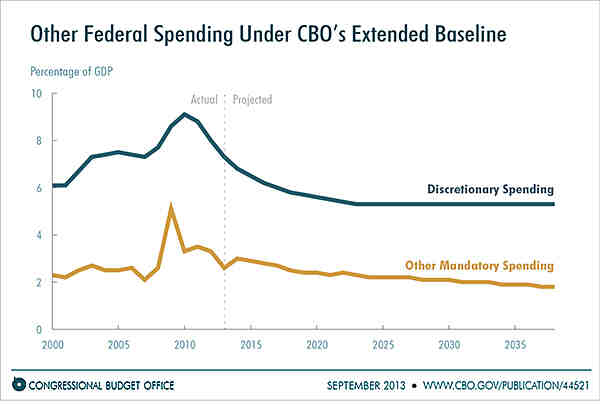BEYOND THE NUMBERS
In debates over the federal budget, you sometimes hear the claim that federal spending is “exploding.” But updated projections from the Congressional Budget Office (CBO) show that most federal spending is actually falling as a share of the economy. It’s a timely reminder as policymakers ponder their next move on deficits.
In a September 19 blog, CBO staff report that in fiscal year 2013, half of federal spending is going for major health programs, Social Security, and interest and the other half for everything else. (Major health programs include Medicare, Medicaid, the Children’s Health Insurance Program, and the Affordable Care Act.) The “everything else” category — essentially, other entitlements and defense and domestic discretionary programs — has averaged 11 percent of gross domestic product (GDP) for the last 40 years and, under current policies, will fall to 7.6 percent in 2023 and 7.1 percent in 2038. The CBO chart below shows the trajectories for the discretionary and mandatory (entitlement) pieces of this “everything else” category.

Spending on the major health care programs and Social Security is rising, due mostly to the aging of America’s population and growing health care costs. But here’s another piece of good news: “The slowdown in health care cost growth has been sufficiently broad and persistent to persuade us to make significant downward revisions to our projections of federal health care spending,” according to CBO Director Douglas Elmendorf.
To be sure, we need to do more to slow health care costs, which “remain the central challenge in putting the federal budget on a sustainable path,” Elmendorf notes. Policymakers can enact some measures soon, as part of a balanced deficit-reduction package, that would achieve significant Medicare savings for the decade ahead without jeopardizing the quality of care or access to care.
Health reform also contains numerous pilot projects and research studies to identify reforms that could eventually produce substantial savings throughout the health care system. By later in the decade, we will know more about what works and what doesn’t and can take further steps to control costs.
